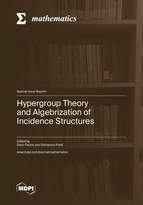Hypergroup Theory and Algebrization of Incidence Structures
A special issue of Mathematics (ISSN 2227-7390). This special issue belongs to the section "Algebra, Geometry and Topology".
Deadline for manuscript submissions: closed (1 December 2022) | Viewed by 16905
Special Issue Editors
Interests: numerical linear algebra; complex networks
Special Issues, Collections and Topics in MDPI journals
Special Issue Information
Dear Colleagues,
Algebraic hyperstructures arise as natural generalizations of ordinary algebraic structures when the composition operator is multivalued. For that reason, the study of algebraic hyperstructures is also called hypercompositional algebra. The pioneer of this theory was the French mathematician Frederic Marty (1911–1940), who introduced the notion of hypergroup in 1934 on the occasion of the 8th Congress of Scandinavian Mathematicians in Stockholm. Three years after, M. Krasner applied that notion in the context of Galois theory, and later, in the 1940s, projective, spherical, and descriptive geometries were characterized by W. Prenowitz using hypergroups.
Hyperstructure theory has experienced a surge of interest since the 1970s, when its research area was greatly expanded by the introduction of other useful concepts: canonical hypergroups, hyperrings, hyperfields, hypervector spaces, semihypergroups, and so on. Later, a number of mostly Italian mathematicians established remarkable relationships between algebraic hyperstructures, finite geometries and, more generally, incidence structures.
Nowadays, hypercompositional algebra has a variety of relationships with other fields of mathematics, such as fuzzy set theory, combinatorics, and probability, established by various research groups around the world. In addition, algebraic hyperstructures are also encountered in computer science, artificial intelligence, and physics.
This Special Issue of the MDPI journal Mathematics invites submissions of significant and original contributions in hyperstructure theory, in a broad sense. Manuscripts may address theoretical aspects, applications, and related computational issues. We welcome contributions dealing with equivalence relations, semi-orderings, graphs and hypergraphs, combinatorial geometry, fuzzy sets, etc., as well as their appearance in the social, natural, and applied sciences.
Prof. Dr. Dario Fasino
Prof. Dr. Domenico Freni
Guest Editors
Manuscript Submission Information
Manuscripts should be submitted online at www.mdpi.com by registering and logging in to this website. Once you are registered, click here to go to the submission form. Manuscripts can be submitted until the deadline. All submissions that pass pre-check are peer-reviewed. Accepted papers will be published continuously in the journal (as soon as accepted) and will be listed together on the special issue website. Research articles, review articles as well as short communications are invited. For planned papers, a title and short abstract (about 100 words) can be sent to the Editorial Office for announcement on this website.
Submitted manuscripts should not have been published previously, nor be under consideration for publication elsewhere (except conference proceedings papers). All manuscripts are thoroughly refereed through a single-blind peer-review process. A guide for authors and other relevant information for submission of manuscripts is available on the Instructions for Authors page. Mathematics is an international peer-reviewed open access semimonthly journal published by MDPI.
Please visit the Instructions for Authors page before submitting a manuscript. The Article Processing Charge (APC) for publication in this open access journal is 2600 CHF (Swiss Francs). Submitted papers should be well formatted and use good English. Authors may use MDPI's English editing service prior to publication or during author revisions.
Keywords
- algebraic hyperstructures
- semi-hypergroups
- Hv-structures
- fuzzy hyperstructures
- join spaces
- semi-orderings
- fundamental relations
- (hyper)-graphs
- designs






